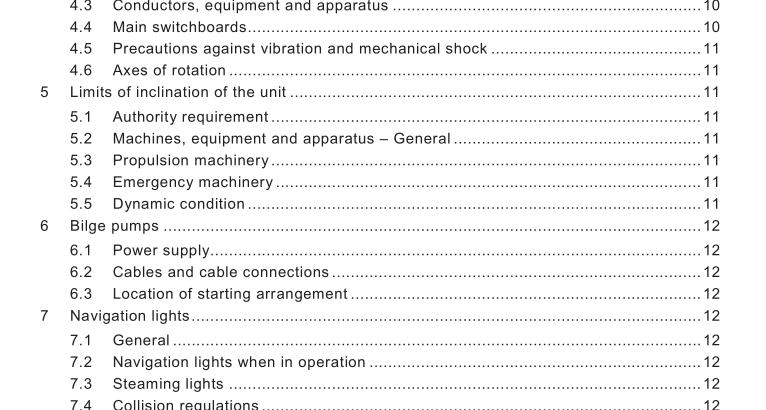BS IEC 61892-5:2010 pdf download – Mobile and fixed offshore units – Electrical installations Part 5: Mobile units4 General requirements
4.1 Protection against flooding In every mobile unit in which electric power is used for the services necessary for the safety of the unit, the generators, switchgear, motors and associated controlgear for such services, with the exception of machinery in the platform of semi-submersibles, shall be so situated or arranged that they continue to operate satisfactorily in the event of partial flooding by bilge water above the tank top in the space in which they are situated.
4.2 Rotating machines Rotating machines shall be installed to minimise the effects of motion. The design of bearings of all machines and the arrangement for their lubrication shall be adequate to withstand the motions encountered in heavy weather and operation for prolonged periods at the list and trim specified in Clause 5 without the spillage of oil.
4.3 Conductors, equipment and apparatus Conductors, equipment and apparatus shall be placed at such a distance from each magnetic compass or shall be so disposed that the interfering external magnetic field is negligible; that is, the total singular deviation shall not exceed 30 min when any combination of circuits is switched on and off.
4.4 Main switchboards The main switchboard shall be subdivided into at least two parts. The subdivision may be effected by removable links, circuit-breakers or other suitable means so that the main generators and any supplies to duplicated services which are directly connected to the busbars are, as far as is practicable, equally divided between the sections.
4.5 Precautions against vibration and mechanical shock Machines, equipment and apparatus shall be unaffected by vibration and shock likely to arise under normal service. Screws and nuts securing current-carrying parts shall be effectively locked so that they cannot work loose by vibration. The locking of screws and nuts securing noncurrent-carrying parts is recommended where necessary.
4.6 Axes of rotation For units where the requirements to dynamic conditions, as specified in 5.5 apply, horizontal rotation machines shall to the extent possible be installed preferably with the shaft in the fore- and-aft direction. Where a machine is installed athwartship, it shall be ensured that the design of the bearings and the arrangements for lubrication are satisfactory to withstand the rolling specified in Clause 5. The manufacturer shall be informed when a machine for installation athwartship is ordered.
5 Limits of inclination of the unit
5.1 Authority requirement Dependent upon the outcome of all studies relevant to the intact and damaged stability of the unit, the appropriate authority may require or permit deviations from the angles stated in 5.2, 5.3 and 5.4. 5.2 Machines, equipment and apparatus – General All machines, equipment and apparatus shall operate satisfactorily under all conditions with the unit upright and when inclined up to the following angles from the normal:
− for column stabilized units, 1 5° in any direction;
− for self-elevating units, 1 0° in any direction;
− for surface units, 1 5° either way in list and simultaneously trimmed 5° by the bow or stern.
5.3 Propulsion machinery
Main propulsion machinery and all auxiliary machinery essential to the propulsion and safety of the mobile unit shall be capable of operating under the static conditions specified in 5.2 and the following dynamic conditions:
– for column stabilized units, 22° 30′ in any direction;
– for self-elevating units, 1 5° in any direction;
– for surface units, 22° 30′ rolling and simultaneously pitching 7° 30′ by the bow or stern.
5.4 Emergency machinery
Emergency machines, equipment and apparatus fitted in accordance with requirements from the appropriate authority for emergency plant shall operate satisfactorily under all conditions with the unit upright and when inclined up to the following maximum angles from the normal:
– for column stabilized units, 25° in any direction;
– for self-elevating units, 1 5° in any direction;
– for surface units, 22° 30′ about the longitudinal axis and/or when inclined 1 0° about the transverse axis.
